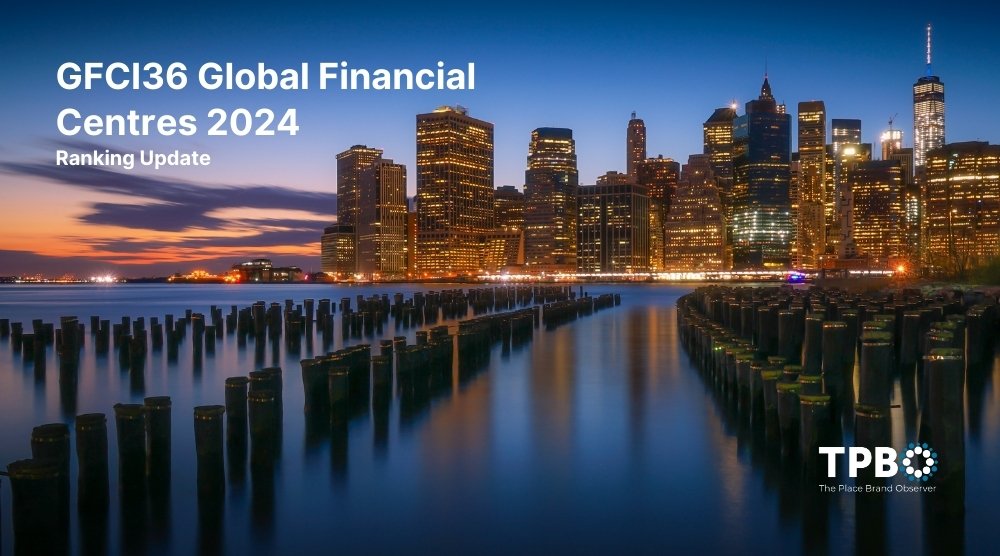The financial world is constantly evolving, and staying ahead of the curve requires an in-depth understanding of global financial centres. The latest Global Financial Centres Index (GFCI) 36, published in September 2024, offers insights into the competitiveness and attractiveness of 121 financial hubs worldwide.
Podcast: Virtual co-hosts Anna and David discuss the Global Financial Centres Index.
Key Highlights from GFCI 36
- Among the leading centres there was little change, only Dublin improved more than four rank places.
- Stable or falling inflation across leading economies suggests slow but continued growth.
- Latin America & The Caribbean is the only region where confidence in the financial sector increased slightly, at an average 0.65%.
- The GFCI 36 considers geopolitical challenges the most significant risk to financial centres in the medium term.
- Competition from other centres and regulatory requirements are secondary challenges.
Top Financial Centres of 2024
| Rank | City | Change in Position |
| 1 | New York | 0 |
| 2 | London | 0 |
| 3 | Hong Kong | +1 |
| 4 | Singapore | -1 |
| 5 | San Francisco | 0 |
| 6 | Chicago | +3 |
| 7 | Los Angeles | +1 |
| 8 | Shanghai | -2 |
| 9 | Shenzhen | +2 |
| 10 | Frankfurt | +3 |
- Shenzhen and Frankfurt rose two and three ranks respectively to enter the top ten.
- Seoul (11) and Geneva (13) fell one and six ranks respectively and left the top ten.
- Chicago and Los Angeles rose in rankings, reflecting the growing importance of U.S. cities, beyond New York, in the global financial landscape.
Biggest Movers and Shakers
| City | Change in Rank | New Rank |
| Bermuda | +27 | 79 |
| Doha | +24 | 64 |
| Riyadh | +21 | 63 |
| Guernsey | +20 | 49 |
| Kuala Lumpur | +18 | 58 |
| Tianjin | -13 | 78 |
| Lisbon | -13 | 87 |
| Nanjing | -14 | 77 |
| Stockholm | -16 | 66 |
| Rome | -22 | 76 |
- Bermuda and Riyadh benefitted from providing specialised financial services.
- Doha reversed its fall from the previous GFCI report and is defined as an emerging international contender.
- Kuala Lumpur was the only centre in the Asia/Pacific region that improved more than 10 places.
Regional Analysis:
Western Europe
- Leaders: London continues to dominate.
- Rising: Guernsey (+20), Dublin (+11), Jersey (+10), Lugano (+9).
- Declines: Rome (-22), Stockholm (-16), Lisbon (-13), Berlin (-11), Munich (-9).
Asia/Pacific
- Leaders: Hong Kong, followed by Singapore, switching positions.
- Rising: Osaka (+3), Chengdu (+4), Kuala Lumpur (+18).
- Declines: Wellington and Guangzhao (-5 each), Sydney (-10), Tianjin (-13), Nanjing (-14).
North America
- Leaders: New York, San Francisco, Chicago, Los Angeles.
- Rising: Montreal (+6), Atlanta and Vancouver (+4 each).
- Declines: Calgary (-4), Minneapolis / St Paul (-7).
Eastern Europe & Central Asia
- Leaders: Astana, Almaty, Tallinn
- Rising: Almaty (+12), Istanbul (+6).
- Declines: Tallinn (-10), Prague (-7), Athens (-6).
Middle East & Africa
- Leaders: Dubai, Abu Dhabi, Tel Aviv.
- Rising: Doha (+24), Riyadh (+21), Kuwait City (+11).
- Declines: Nairobi (-7), Bahrain (-4).
Latin America & The Caribbean
- Leaders: Bermuda, Cayman Islands, São Paulo.
- Rising: Bermuda (+27), Bahamas (+8).
- Declines: Santiago de Chile (-4).
Methodology of GFCI 36:
The GFCI uses a factor assessment model, combining both survey responses and statistical data to create a comprehensive ranking. Key components include:
- Survey: Ratings from over 150 professionals collected through an online questionnaire.
- Statistical Model: Quantitative data from 145 instrumental factors provided by third parties such as the World Bank, the Economist Intelligence Unit, the OECD, and the United Nations. These factors are grouped into five areas: Business Environment, Human Capital, Infrastructure, Financial Sector Development, and Reputation.
About Z/Yen:
Founded in 1994, Z/Yen is a leading think-tank by Long Finance, specialising in finance and technology. The GFCI was first released in March 2007 and continues to provide crucial insights into the competitiveness of global financial centres. Updates are released every March and September.
Conclusion:
The Global Financial Centres Index 36 reaffirms the dominance of established financial hubs with New York and London maintaining their top positions, and Hong Kong edging out Singapore for third place.
The stability of leading centres, coupled with falling inflation across major economies, suggests a period of slow but continued growth. The significant rank changes for centres like Bermuda, Doha, and Riyadh underscores the importance of specialised services and emerging contenders.
Regionally, although Western Europe and North America lead and the Middle East showing strong growth, Latin America emerges as the only region with increased financial sector confidence.
Looking ahead, the GFCI 36 identifies geopolitical challenges as the most significant medium-term risk for financial centres, followed by competition and regulatory requirements. This underscores the need for financial hubs to remain adaptable and resilient in an ever-changing global economic landscape.
Visit the Long Finance website for details on rankings and methodology.
Enjoyed this update on the Global Financial Centres Index 2024? Spread the word!
Want more? Explore our City Observatory for snapshots of how major cities around the world compare in terms of economic performance, city brand strength, sustainability and reputation.


